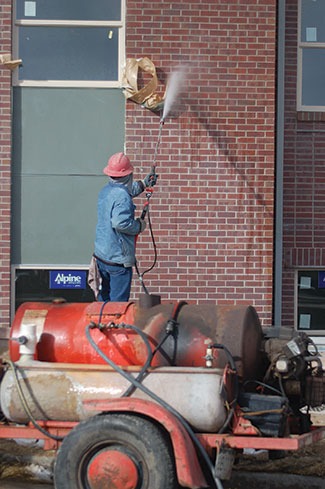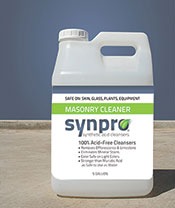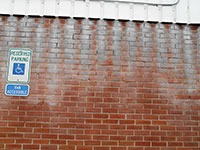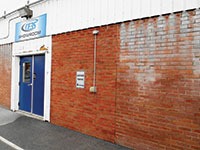June 2014
Cleaning
The Elements of Cleaning
 |
|
Cleaning – every kind of cleaning – involves three elements: temperature, agitation and cleaning agent. Different jobs require different measures of each element to be successful.
Let’s use an example everyone knows: washing your hands. When your hands are really grimy and dirty, nothing cleans better than a scrub brush, gritty soap, and hot water from the tap. The water is providing the temperature, the brush gives agitation, and the strong soap is the cleaning agent. If you only have mild soap, you can still get your hands clean, but it will take more severe or longer brushing. You have decreased one element and increased another. When your hands are not so dirty and don’t need as much cleaning power, you can get them just as clean by rubbing your hands together to provide agitation, much less than the scrub brush, using milder hand soap, much less than the gritty soap, and the same hot water from the tap. You adjust the cleaning elements to minimize the wear and tear on your hands, using only the cleaning power necessary to get your hands clean.
Cleaning hard surfaces is quite the same. You need the right combination of temperature, agitation and cleaning agent. The right combination depends on the composition of the surface and substrate, the nature and extent of the unwanted matter, and the temperature of the water supply. Often, you can have a pretty good idea of the issues surrounding the cleaning job to be done. However, using a little caution as a starting point is wise.
Trial and error on a relatively concealed section of the surface will give you the knowledge required to understand what combination of pressure, agitation and cleaning agent will yield the best results without unnecessary risk. You may have cleaned similar surfaces in the past and think you know the limits and requirements. However, when dealing with surfaces like brick, stone, cement block, marble and faux stone, nature and manufacturing variances and, yes, mistakes will change the conditions and requirements.
| ?? |
|
||
| ?? | ?? |
New Construction
Let’s take a look at some specific cleaning situations you might run into with new construction. In the discussion, we will talk about water pressure. If you can apply the cleaning agent with hot water you, increase the temperature element. Since the other elements don’t change, you will reduce the amount of chemical agent needed and, thereby, reduce your cost of cleaning.
It is important to remember when using a high-pressure water sprayer that the actual pressure of the water hitting the wall is a function of how close the wand is held to the surface. As the distance from the wand to the wall increases, there is a dramatic reduction in the pressure when using a fan-shaped nozzle. For example, when using a 15-degree nozzle, which is the smallest fan available, when the wand is held 12 inches from the surface and the water sprayer gauge mounted on the machine indicates 3,000 psi, the water is actually hitting the wall at less than four psi.
- Glazed Brick: Glazed brick is hard and does not easily absorb the mortar, so often you can use relatively high pressure, little cleaning agent, and hot water to remove mortar and its film.
- Standard Red Brick: New red brick is generally hard but porous. Therefore, you will probably want to use high water pressure, a masonry cleaning chemical, and hot water.
- Colored Brick: Colored brick involves additional challenges, because the chemicals that provide the color react with the cleaning agent to give unwanted color inconsistency. You will want to use high water pressure, a cleaning agent specifically made for cleaning colored brick, and hot water. Because the specialized cleaning agent is less powerful than regular cleaning products, you may need to use more to maintain an acceptable level of productivity.
- Cement Brick: Though cement brick is hard, the material will etch and expose some aggregate if the cleaning agent contains acid. If the color is not embedded into the brick, you will also get some color change with the etching. The difficulty is that you need some acidity to remove the mortar, while minimizing the effect of the acid on the cement. Using high-pressure hot water and minimizing the use of a cleaning agent is best. The usual solution to the dilemma is to try to minimize the etching, while making it consistent over the entire surface. Getting the architect’s agreement on the desired appearance is critical.
- Cement Block: Block has some of the same problems as cement brick; you need acidity to remove the mortar, but it will etch the surface, exposing aggregate. For this cleaning situation you may want to increase the hot water pressure, either by holding the wand closer to the surface than you normally would or using a more aggressive rotating nozzle and an appropriate cleaning agent.
- Raked Surface Brick: A raked surface, because it will absorb more mortar, will require an increase in the cleaning agent with high-pressure hot water.
- Sand Faced Brick: To maintain the sand face, you will need to greatly reduce the agitation by reducing water pressure, increase the cleaning agent quantity and using hot water.
- Faux Stone: Typically, faux or veneer stone is manufactured by pouring concrete into a variety of molds, and then coloring each piece. The coloring is painted on the surface, so using any amount of agitation and cleaning agent may deface the stone. At present, manufacturers do not have any recommendations for cleaning it, other than very low-pressure water to remove any environmental discoloration.
- Cast Stone: Care should be taken to avoid the need to clean cast stone. This should be done by covering the pieces with plastic to avoid getting mortar on the surface. Any cleaning agents that will remove mortar will etch the surface of the cast stone, changing its appearance and streaking it. Therefore, if the cast stone is used with materials that will be cleaned, the cast stone must be protected from the runoff.
- Natural Stone: Certain stones, such as sandstone and limestone, will not tolerate cleaning with acid-based cleaners as the acid will dissolve naturally occurring elements in the rock. Moderate pressure can be used with specialized non-acidic cleaning agents and hot water.
Restoration and Rehabilitation
Restoration cleaning involves two additional variables, which require you to reevaluate the three elements of cleaning – temperature, agitation and cleaning agent – and to make different choices depending on additional considerations. You not only have to consider the composition of the surface material but also the nature of the stains and the environmental impact of the cleaning agent.
Often, it is necessary to assay the composition of the original surface and mortar, the composition of any previous repairs and modifications, and the nature of the stains and to consider the surroundings of the project. It would be quite normal to have other structures in close proximity, stringent regulations on runoff, and an occupied structure. Stains will range from carbon black to acid rain and rust from deteriorating ornamentation and structural elements.
The only way to determine the best cleaning methodology and process is to involve material analysts and building preservation experts. Specialized restoration cleaning agents are available to treat a variety of stains. Chemical manufacturers will give guidance with regard to which chemicals they formulate for particular types of surfaces and stains. It may be necessary to limit agitation from water pressure, if the surface is particularly soft. In most cases, temperature and the proper cleaning agent will need to combine to provide cleaning power as agitation will need to be minimized and may be limited to hand brushing.
Conclusion
There are some generalities that you can consider when balancing agitation, temperature and cleaning agent.
Increasing the temperature of the cleaning agent and the surface to be cleaned, either by using hot water and heating the cleaning agent with the water or creating friction by brushing, will increase the power of the cleaning agent. If you want the cleaning agent to be less powerful, decrease the temperature or use less.
Generally, agitation is accomplished either by water pressure or manpower using brushes or even rags. It sure is easier to let water pressure do the job, if the surface will tolerate it.
Chemicals represent the greatest variable cost in cleaning, so it is important to identify the chemical with the right balance of power and cost. There are seemingly unlimited choices in cleaning agents. Sometimes the choice comes down to what you’ve had the best experience with and what is most available to you. Sometimes the choice is made by the designer, who perhaps made the choice based on what specification happens to be most available on his computer. Other times, it is important to choose the right formulation for the job at hand and to vary the amount of agent being used to get the job done in an acceptable amount of time and at an acceptable cost.
In short, you need the right balance of temperature, agitation and cleaning agent to get your cleaning job done. Varying any of the elements will impact the others, and reducing the power of one of the elements can be compensated for by increasing another. You will have an important cost advantage if you increase the temperature of the cleaning agent and, thereby, decrease the amount of agent needed.
Ronald W. Baer is President of Kem-O-Kleen. Kem-O-Kleen has manufactured equipment for all kinds of masonry cleaning for more than 40 years. He may be reached at 800-274-4121 and welcomes your comments.
| Tackling Cleaning Challenges |
||||||||
Problem: For more information, contact Robert Port, technical support with Restoration Direct Inc., 800-288-7800. |
 The masonry industry – and the construction industry, in general – must continue moving toward the use of more environmentally friendly cleaning solutions and products. Home owners and project managers increasingly demand more of contractors to use products that are safer, cleaner and more environmentally friendly, yet effective. As home owners and project owners continue to demand more of contractors, they, in turn, demand more of cleaning product manufacturers.
The masonry industry – and the construction industry, in general – must continue moving toward the use of more environmentally friendly cleaning solutions and products. Home owners and project managers increasingly demand more of contractors to use products that are safer, cleaner and more environmentally friendly, yet effective. As home owners and project owners continue to demand more of contractors, they, in turn, demand more of cleaning product manufacturers.

